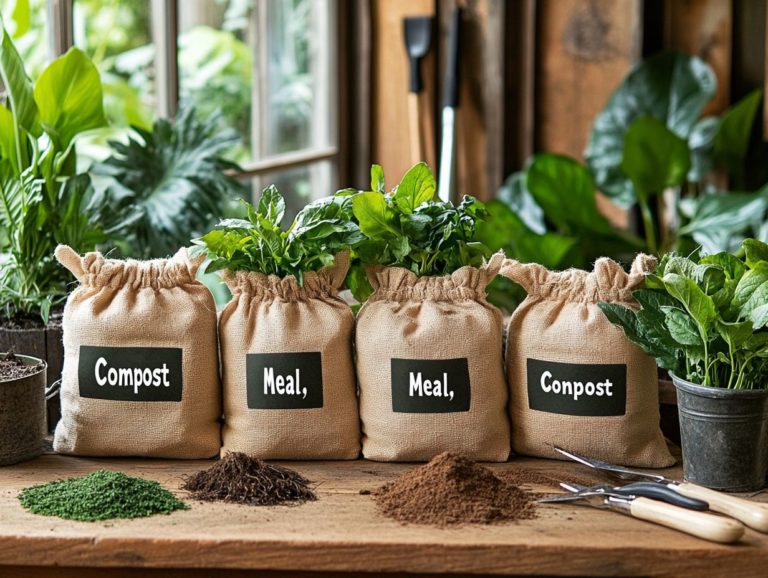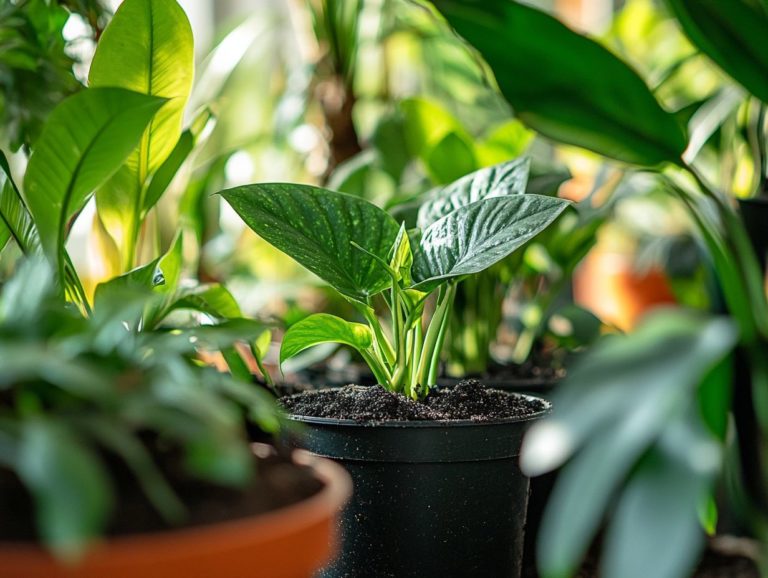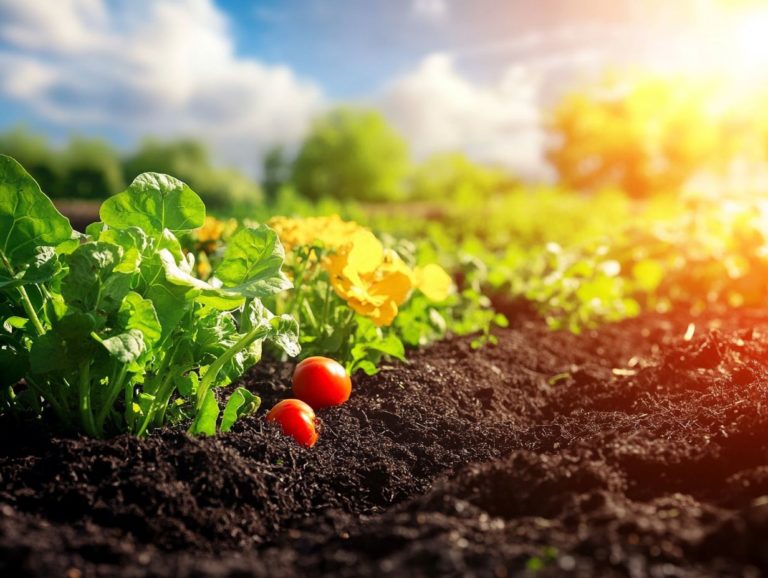What to Know About Soil for Succulents Indoors
Succulents have undoubtedly won your heart with their unique beauty and effortless charm.
To ensure these resilient plants flourish, it’s crucial to grasp their specific soil requirements.
This guide delves into the nuances of succulent care. It will help you differentiate between indoor and outdoor varieties while selecting the perfect soil.
You ll discover practical tips for soil preparation, maintaining its quality, and steering clear of common missteps.
Ready to give your succulents the perfect foundation? Let s jump in!
Contents
- Key Takeaways:
- Understanding Succulents and Their Needs
- Choosing the Right Soil for Indoor Succulents
- Preparing the Soil for Succulents
- Maintaining Soil Quality for Succulents
- Common Mistakes to Avoid with Succulent Soil
- Alternative Soil Options for Succulents
- Frequently Asked Questions
- What should I know about soil for succulents indoors?
- What type of soil is best for succulents?
- Can I use regular potting soil for my indoor succulents?
- How often should I water succulents planted in indoor soil?
- Do I need to add fertilizer to my indoor succulent soil?
- Can I reuse soil from my outdoor succulents for indoor succulents?
Key Takeaways:
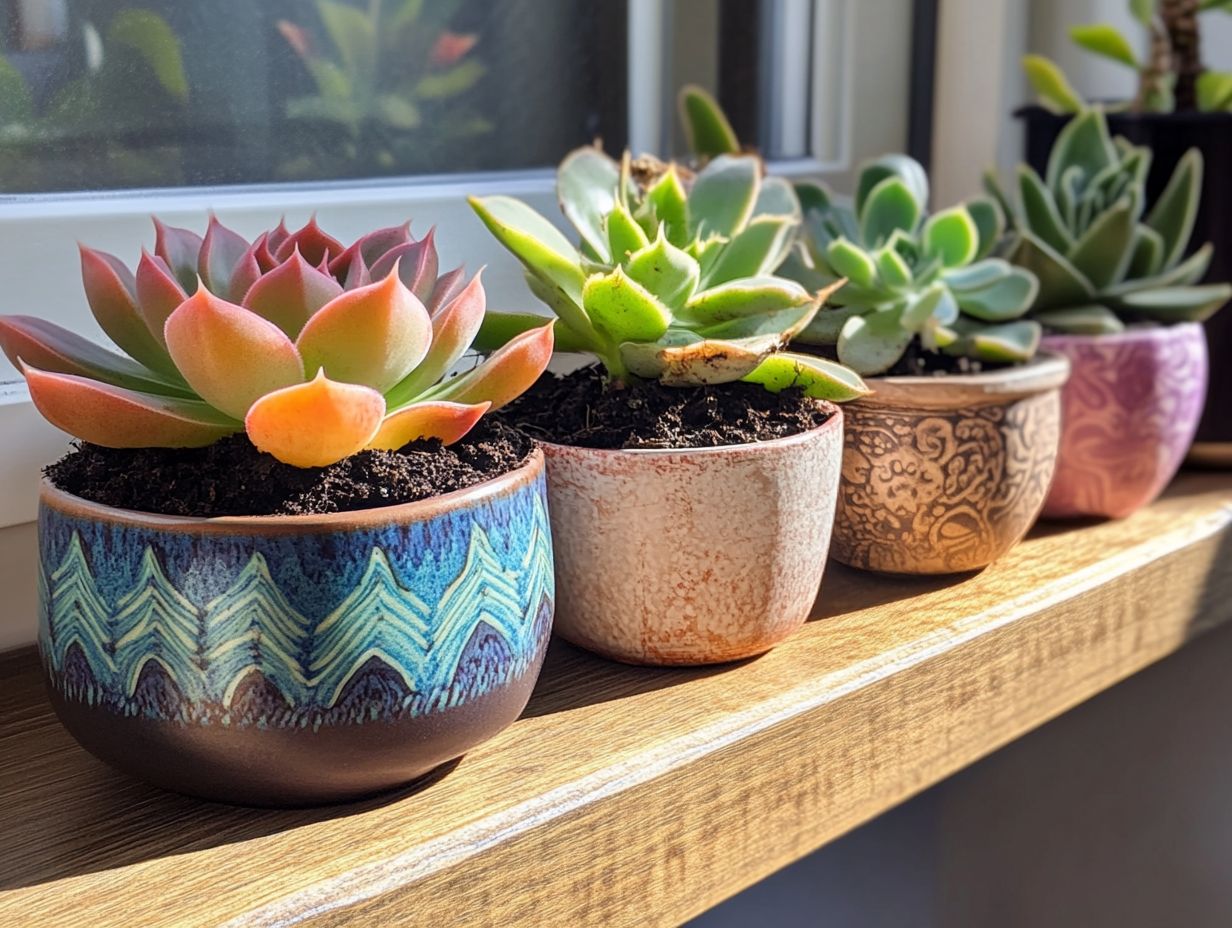
- Succulents have unique water and light requirements that make them different from other plants.
- Indoor succulents require a well-draining soil mix to prevent root rot and promote healthy growth.
- Proper soil preparation and maintenance are crucial for the long-term health of indoor succulents.
Understanding Succulents and Their Needs
Succulents are truly exceptional houseplants, known for their striking diversity and low-maintenance requirements. These remarkable plants, including favorites like Aloe Vera, Echeveria, and Jade Plant, possess the unique ability to store water in their leaves. This allows them to flourish even in arid conditions.
To ensure your succulents thrive, it s crucial to grasp their specific needs. Key factors include optimal humidity levels and challenges like overwatering and root rot. This understanding is particularly vital for indoor succulents, which may encounter fluctuating environmental factors.
With the right care, these resilient beauties can bring a touch of elegance to your space.
What Makes Succulents Unique?
Succulents are celebrated for their remarkable ability to store water. This unique trait helps them thrive in arid landscapes, much like the deserts where cacti flourish.
These hardy plants have specialized tissues that allow them to retain moisture, often shown through their thick, fleshy leaves or stems. Among the various succulent families, like Crassulaceae and Euphorbiaceae, you’ll notice fascinating variations in leaf structure and shape. These adaptations enable different species to maximize photosynthesis, even under extreme conditions.
Adding to their charm is a remarkable process that helps succulents use carbon dioxide at night. This allows them to photosynthesize efficiently when temperatures drop. These unique features enhance their drought resistance and distinguish them from more traditional flora, showcasing their resilience and versatility across diverse habitats.
Indoor vs. Outdoor Succulents
The distinction between indoor and outdoor succulents revolves around their specific environmental requirements, particularly temperature, air circulation, and humidity levels.
Indoor succulents often struggle to adapt to the dry, warm conditions typical of homes. This makes them more susceptible to issues like mold growth and pest infestations.
In contrast, outdoor succulents thrive in a wider range of natural conditions, allowing them more freedom. However, indoor varieties need your careful attention to their surroundings.
Growing indoors has its perks, like easy access to water and controlled sunlight. However, maintaining consistent humidity and temperature is a unique challenge.
To optimize your indoor succulent care, consider using tools like humidifiers or pebble trays to boost moisture levels. Ensure adequate airflow with well-placed fans or open windows.
Utilizing moisture meters can be a game-changer. They allow you to accurately gauge the needs of these resilient plants and ensure they thrive, despite the challenges of indoor living and common problems like root rot.
Choosing the Right Soil for Indoor Succulents
Selecting the right soil for your indoor succulents is vital for their health. It directly influences their growth, drainage capacity, and overall well-being.
A balanced succulent soil mixture should blend organic and mineral matter. This ensures proper airflow and moisture retention, while avoiding overwatering and root rot.
Opt for potting soil specifically formulated for succulents. Alternatively, you can create your own DIY potting mix with ingredients like coarse sand, perlite, and pumice. Understanding why soil quality matters for indoor plants greatly improves drainage and creates the ideal environment for these resilient plants, ensuring they thrive.
Factors to Consider
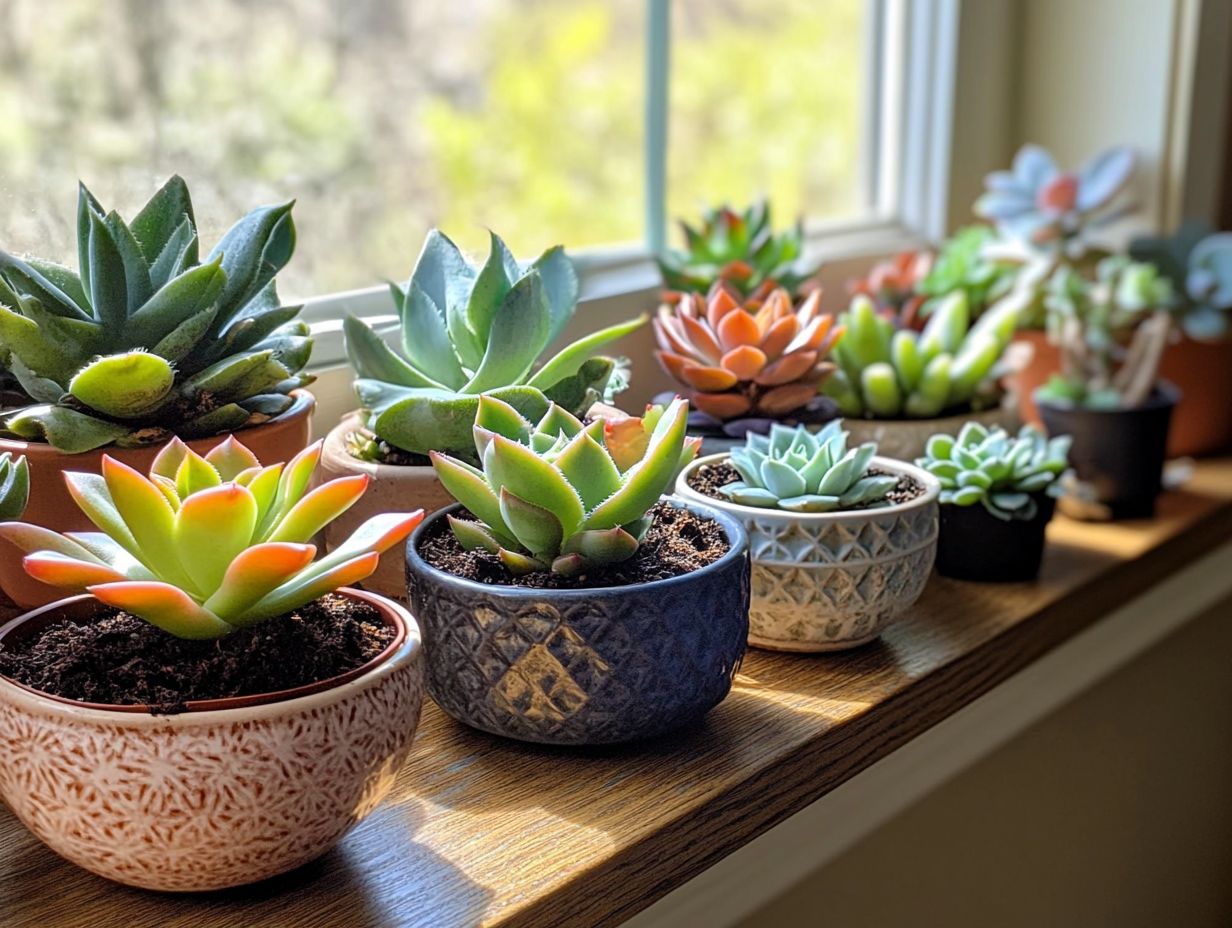
When selecting succulent soil, consider several key factors. These include drainage capacity, temperature compatibility, and the optimal balance of organic and mineral matter to promote healthy growth.
These factors extend beyond the soil itself. The specific types of succulents you plan to plant will significantly influence your ideal mix. Some succulents flourish in gritty, fast-draining mediums, while others prefer richer, more moisture-retentive options.
Evaluate your local environmental conditions. Factors like humidity and temperature can dramatically affect growth.
A simple test can assess soil quality. Whether you choose a commercially available blend like Miracle Grow or craft a customized DIY soil solution, make sure to include necessary amendments to boost drainage.
Preparing the Soil for Succulents
Preparing the soil for your succulents is crucial for healthy growth. This step helps circumvent common problems like overwatering and root rot.
A well-crafted succulent soil whether a store-bought blend or a DIY potting mix should feature well-draining elements like perlite, pumice, and coarse sand. This combination ensures optimal aeration and moisture control.
By properly preparing the soil, you elevate the growing conditions for your succulents. This significantly mitigates the risks linked to poor drainage and compacted soil.
Steps for Proper Soil Preparation
The steps for proper soil preparation begin with selecting the right ingredients think succulent soil, perlite, and pumice. Mixing them in the right ratios is crucial for achieving optimal drainage.
- Measure out equal parts of succulent soil and perlite. Then, add a third of pumice to enhance aeration and moisture retention.
- Combine the ingredients until the mixture is homogeneous. Each ingredient should mingle thoroughly for the best results.
- To test the drainage capacity, pour water through the mixture. It should flow freely without pooling.
- If the mixture retains too much moisture, consider increasing the pumice ratio to improve drainage.
Depending on the specific needs of your succulents, such as their light or moisture sensitivity, you may need to make adjustments. This ensures they thrive in varying humidity levels.
Maintaining Soil Quality for Succulents
Maintaining soil quality for your succulents is essential for their immediate and long-term health. Periodically assess factors like drainage capacity, organic matter, and the overall structure of the soil.
A well-draining soil mixture supports their care and minimizes common issues, such as overwatering, which can lead to dreaded root rot.
Regularly check soil texture and moisture levels to ensure your succulents thrive. Adapt their care as needed, creating the ideal growing environment for these resilient beauties, including types like Haworthia.
Now that you know how to prepare the perfect soil, get started on your succulent journey today!
Tips for Keeping Soil Healthy
To keep your succulents happy, regularly check their soil. Focus on how well it drains and how much organic matter it contains. This ensures your plants receive the nutrients they require and helps prevent issues like root rot.
Consider adding amendments like perlite or coarse sand to improve drainage and create a texture that’s ideal for growth. You can also adjust your watering schedule based on the seasons. During the growing season, you may need to water more often, while in cooler months, less frequent watering is a good idea.
Regularly mixing in organic matter, such as compost or well-rotted leaf litter, boosts nutrient availability and promotes the beneficial microbial activity vital for vibrant plant health. Observing how your succulents respond to these changes will give you valuable insights into their specific needs, allowing you to make proactive adjustments.
Common Mistakes to Avoid with Succulent Soil
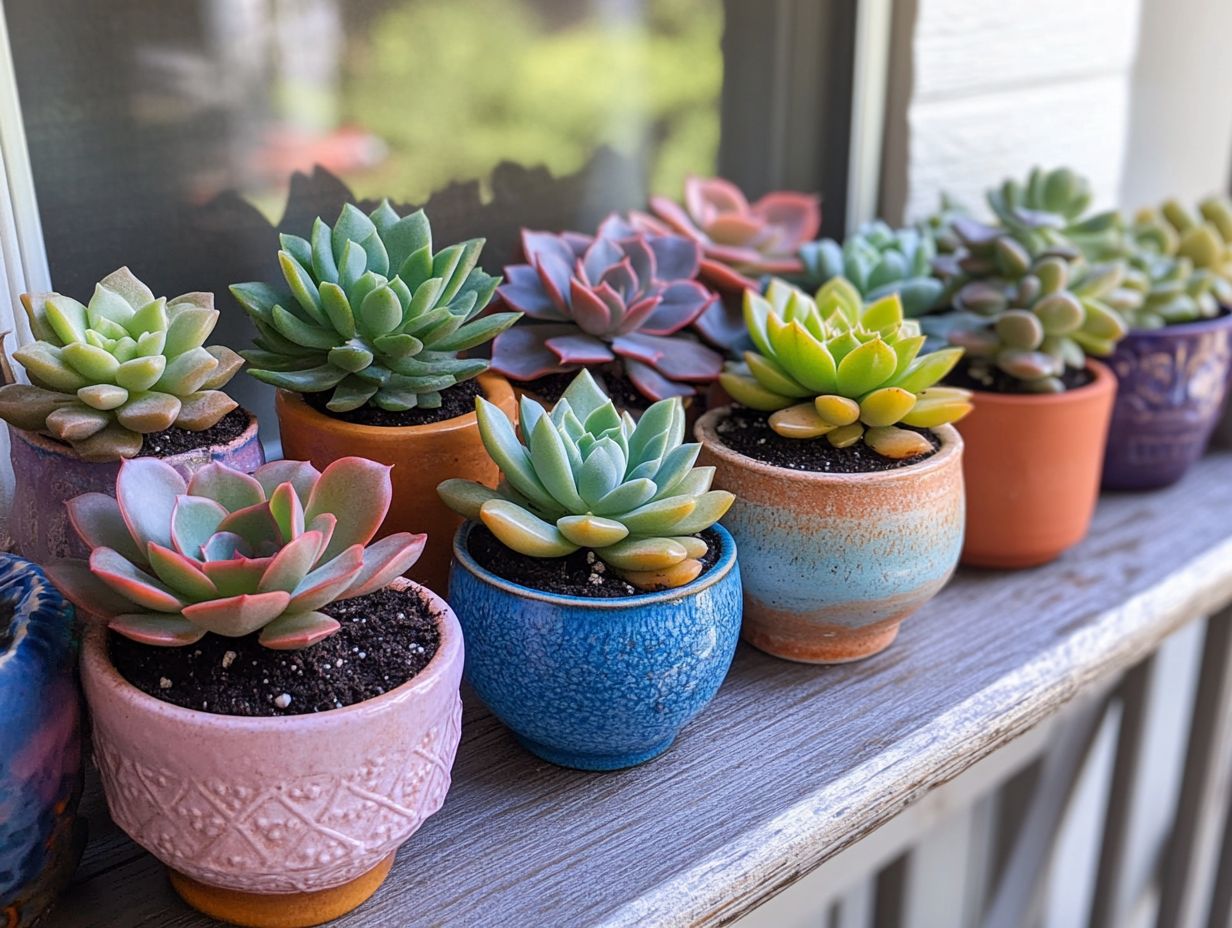
Avoiding common mistakes when working with succulent soil is essential for ensuring the health and longevity of your plants. Overwatering and poor soil quality can lead to root rot.
Many succulent lovers accidentally create conditions for root rot. Using the wrong soil or neglecting drainage can lead to trouble. By recognizing these potential pitfalls and mastering effective soil management techniques, you can prevent common problems with succulent care and nurture thriving plants.
Preventing soil-related issues like overwatering and root rot starts with understanding your succulents’ needs and ensuring proper soil drainage.
Selecting soil mixtures that balance aeration and moisture retention creates an optimal environment for your plants. Regularly check the soil’s moisture level before watering to avoid waterlogging, which is too much water that can drown the roots.
Good drainage is essential for happy, healthy plants because excess water can harm root health. If you overlook these factors, you risk nurturing weak plants that struggle to thrive.
To maintain healthy soil, enrich your mixes with organic materials like perlite or sand, and ensure your pots have drainage holes to control moisture effectively.
Alternative Soil Options for Succulents
Exploring alternative soil options for your succulents opens up exciting possibilities for creating optimal growing conditions. You can choose specialized potting soil or even craft your own DIY potting mix.
Commercial options like Miracle Grow and Bonsai Jack offer pre-mixed solutions specifically formulated for succulents, while a custom blend can be tailored to meet the unique needs of your plants.
By understanding the benefits and characteristics of these various soil types, you can ensure your succulents thrive in the best possible environment.
Exploring Different Soil Mixes
Exploring various soil mixes for succulents reveals textures and components designed to meet their unique needs especially regarding drainage and aeration.
The ideal mix often features a harmonious blend of potting soil, sand, and perlite or pumice to keep the roots from waterlogging. A popular combination is two parts cactus mix to one part perlite, known for promoting healthy growth and preventing root rot.
For specific types, such as jade plants, you may prefer a coarser mix, while more delicate varieties might thrive in a finer texture. Don’t hesitate to experiment with custom blends; adding organic matter like coconut coir can improve moisture retention without sacrificing drainage.
Tailor your soil mix to fit each succulent s needs for the best results.
Frequently Asked Questions
Got more questions? Dive in and discover the best soil for your succulents!
What should I know about soil for succulents indoors?
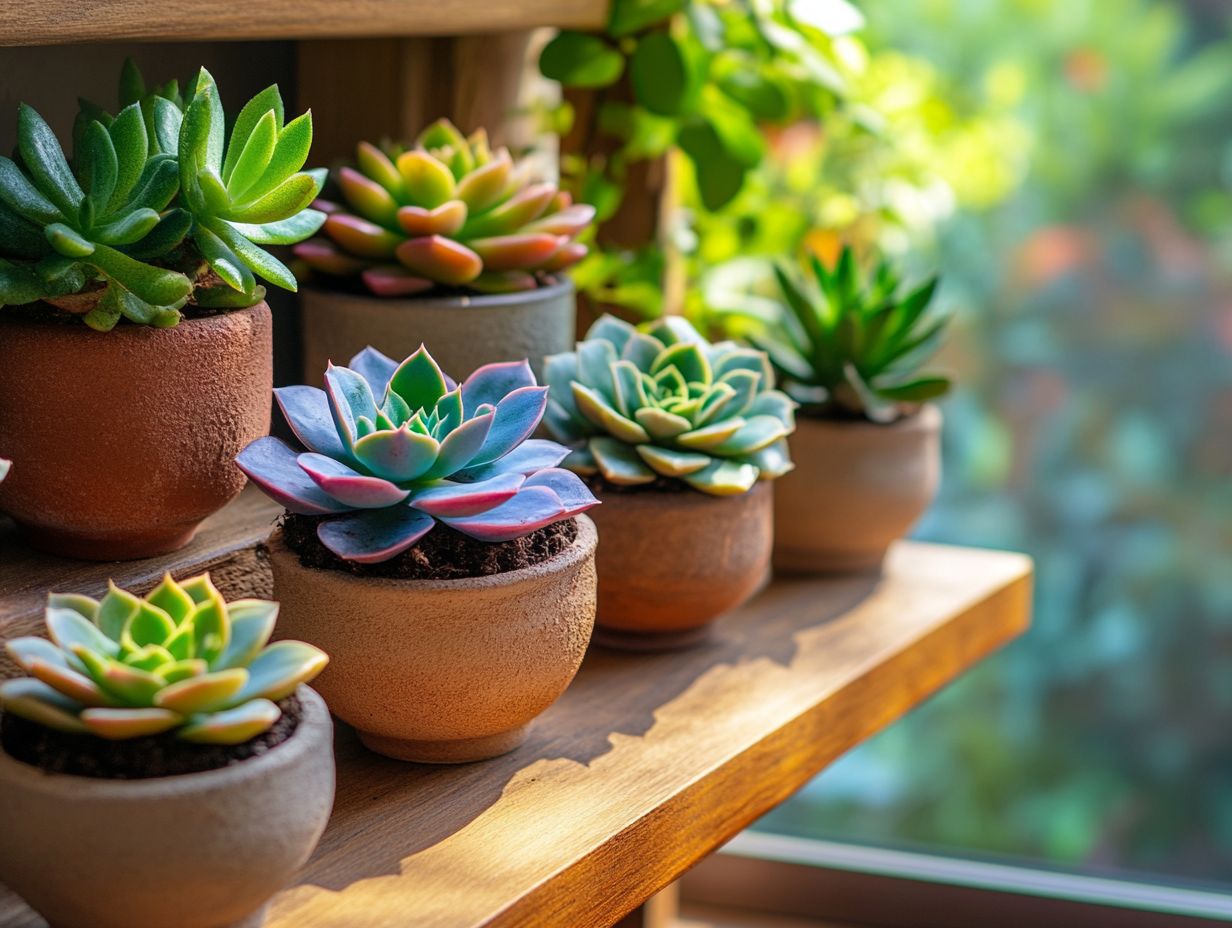
Succulents are popular houseplants. They require low maintenance and have a unique appearance.
Choosing the right soil is crucial for your indoor succulents. It helps ensure their health and growth.
What type of soil is best for succulents?
Succulents need well-draining soil to thrive. A good potting mix includes organic and inorganic materials like perlite, sand, and compost. Perlite is a lightweight material that helps with drainage.
Can I use regular potting soil for my indoor succulents?
No, regular potting soil retains too much moisture. This can cause root rot and may kill your plant. Use a well-draining soil specifically made for succulents.
How often should I water succulents planted in indoor soil?
Succulents don’t need frequent watering like other houseplants. Generally, water them once a week or when the soil is completely dry, depending on humidity and temperature.
Do I need to add fertilizer to my indoor succulent soil?
You don t need to fertilize your succulents, but it can help them grow better. If your potting mix has nutrients, you might not need to fertilize at all.
Can I reuse soil from my outdoor succulents for indoor succulents?
It s not recommended to reuse outdoor soil for indoor plants. Outdoor soil can carry pests and diseases that harm your indoor succulents. Use fresh potting mix instead.
Get ready to transform your space with vibrant indoor succulents! Start planting your indoor succulents today for a beautiful, low-maintenance garden!

